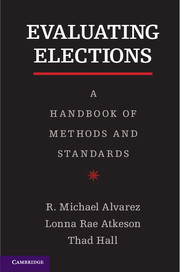Book contents
- Frontmatter
- Contents
- Acknowledgments
- Introduction
- 1 The Electoral Ecosystem
- 2 Easily Available Data for Performance Evaluation
- 3 Measuring the Experiences of Voters
- 4 Measuring the Performance of Poll Workers
- 5 Auditing the Election Ecosystem
- 6 Election Observation
- Conclusion
- Appendix: Precinct Opening, Closing, Election Day Forms
- References
- Index
6 - Election Observation
Published online by Cambridge University Press: 05 December 2012
- Frontmatter
- Contents
- Acknowledgments
- Introduction
- 1 The Electoral Ecosystem
- 2 Easily Available Data for Performance Evaluation
- 3 Measuring the Experiences of Voters
- 4 Measuring the Performance of Poll Workers
- 5 Auditing the Election Ecosystem
- 6 Election Observation
- Conclusion
- Appendix: Precinct Opening, Closing, Election Day Forms
- References
- Index
Summary
So far, we have focused on the use of quantitative data to study election system performance: voter and poll worker surveys, studies of residual votes, and how such data can be used for performance-based management. In this chapter, we turn to an entirely different source of data, but one that is critical for determining electoral performance. Here we focus on direct personal examination of an election by trained observers.
Election observation is a type of qualitative data analysis; collection of these data normally focuses on a relatively small number of precincts that are studied closely and intensely. It is qualitative because it relies primarily on the eyes and ears of observers and on their perceptions, intuition, and experience. It is qualitative because what observers focus on in one precinct might differ dramatically from what they might focus on in another precinct. Although all of this can make qualitative data difficult to analyze in a systematic manner, it does not mean that qualitative analysis of election performance by observers is inferior to other types of data analysis. This also does not mean that no systematic data are collected during the process. Indeed, we advise that the collection of qualitative, observational data includes some more systematic components.
- Type
- Chapter
- Information
- Evaluating ElectionsA Handbook of Methods and Standards, pp. 130 - 145Publisher: Cambridge University PressPrint publication year: 2012



